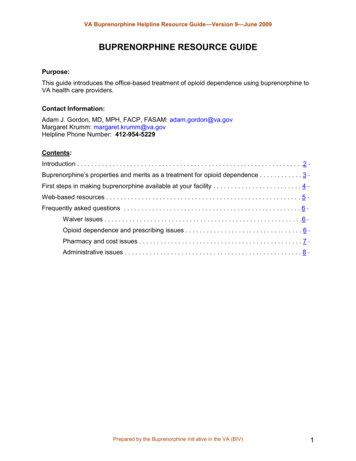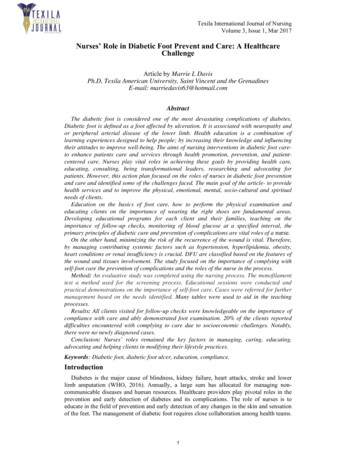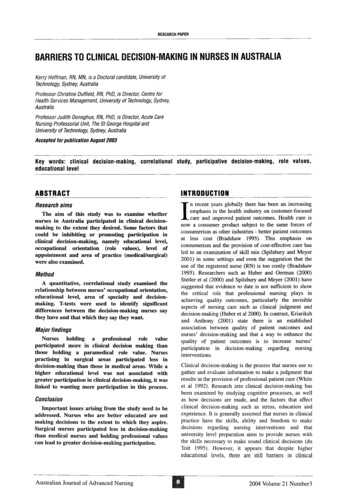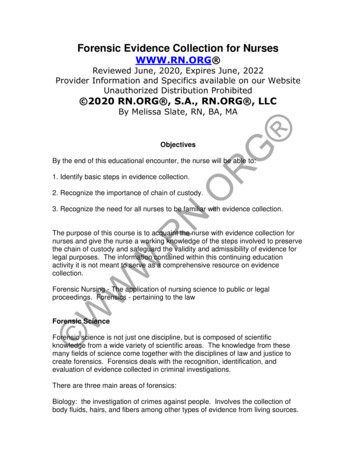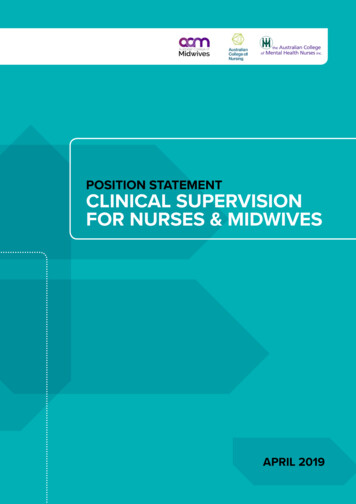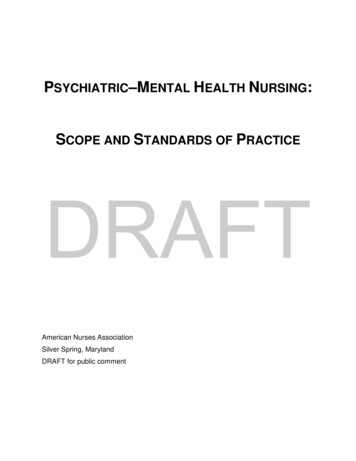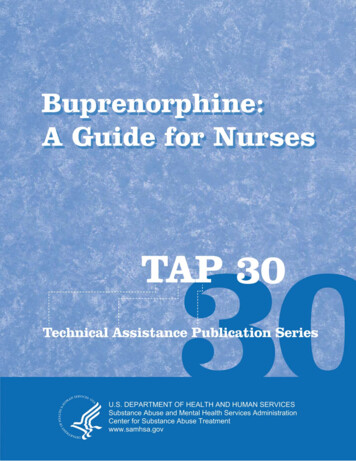
Transcription
BUPRENORPHINE: A GUIDE FOR NURSESTechnical Assistance Publication (TAP) Series30U.S. DEPARTMENT OF HEALTH AND HUMAN SERVICESSubstance Abuse and Mental Health Services AdministrationCenter for Substance Abuse Treatment1 Choke Cherry RoadRockville, MD 20857
AcknowledgmentsThis report was prepared for theSubstance Abuse and Mental HealthServices Administration (SAMHSA) byLTJG Sara Azimi-Bolourian, B.S.N.,M.S.N., M.H.A., M.B.A. (Center forSubstance Abuse Treatment (CSAT),and Katherine Fornili, M.P.H., R.N.,C.A.R.N. (University of MarylandSchool of Nursing). Abt Associates, Inc.,provided editorial and productionassistance under contract/task ordernumber 270-03-9003, U.S. Departmentof Health and Human Services (HHS),SAMHSA. Kathleen ThompsonGargano, R.N., and Colleen LaBelle,R.N., provided expert nurse review.Raymond D. Hylton, Jr., R.N., M.S.N.(CSAT) edited this publication, andMr. Hylton and Michele Westbrookserved as CSAT’s Government ProjectOfficers. SAMHSA reviewers providedexpert content review:Robert Lubran, M.S., M.P.A.(CSAT)Nicholas Reuter, M.P.H.(CSAT)CAPT Melissa Rael, M.P.A., R.N.,B.S.N.(CSAT)DisclaimerThe views, opinions, and content ofthis publication are those of theauthors and do not necessarily reflectthe views, opinions, or policies ofSAMHSA or any other part of HHS.Public Domain NoticeAll material appearing in this documentis in the public domain and may bereproduced or copied withoutpermission from SAMHSA. Citation ofthe source is appreciated. However, thispublication may not be reproduced ordistributed for a fee without the specific,written authorization of the Office ofCommunications, SAMHSA, HHS.Electronic Access and Copiesof PublicationThis publication may be accessedelectronically through the followingInternet World Wide Web connection:http://www.kap.samhsa.gov. Foradditional free copies of this document,please call SAMHSA’s NationalClearinghouse for Alcohol and DrugInformation at 1–800–729–6686 or1–800–487–4889 (TTD) or visithttp://www.ncadi.samhsa.gov.Recommended CitationCenter for Substance AbuseTreatment. Buprenorphine: A Guidefor Nurses. 2009. DHHS Pub. No.(SMA) 09-4376. Rockville, MD:Substance Abuse and Mental HealthServices Administration.Originating OfficeDivision of Pharmacologic Therapies,Center for Substance AbuseTreatment, Substance Abuse andMental Health ServicesAdministration, 1 Choke Cherry Road,Rockville, MD 20857.DHHS Publication No. (SMA) 09-4376Printed 2009
ContentsIntroduction . 1Purpose of This Guide . 1Learning Objectives. 1Background . 3Data 2000: Legislative Authority for Buprenorphine Treatment . 3Physicians’ Qualifications . 3Buprenorphine and the Role of the Nurse . 7Buprenorphine Pharmacology . 9General Opioid Pharmacology . 9Opioid Receptors . 9The Functions of Opioids at Receptors . 9Full Agonists . 9Antagonists. 9Partial Agonists. 9Consequences of Repeated Administration and Withdrawal of OpioidDrugs . 10Spontaneous Withdrawal . 10Precipitated Withdrawal . 10Affinity, Intrinsic Activity, and Dissociation . 11Characteristics of Abused Drugs . 11Pharmacological Properties . 12Monotherapy and Combination Therapy . 12Dosing . 12Abuse Potential . 13Safety Profile . 13Pregnancy . 14Adverse Effects . 15Interactions, Cautions, and Contraindications . 15Allergic Reactions . 16Cost and Supply. 17Buprenorphine Treatment Protocols—Office-Based Treatment . 19Medically Supervised Withdrawal (Opioid Detoxification WithBuprenorphine) . 19Classifications of Medically Supervised Withdrawal . 21Maintenance Treatment. 21v
Buprenorphine: A Guide for NursesPrecipitated Withdrawal and Withdrawal Symptoms . 25Avoiding Precipitated Withdrawal . 25Assessment of Withdrawal Symptoms . 25Helping Patients Manage Mild Withdrawal Symptoms . 26Tapering . 27Self-Management of Mild Withdrawal Symptoms With Over-the-Counter orPrescription Medications . 27Management of Patients With Co-Occurring Pain . 27Pain Assessment . 28Multimodal Approach to the Treatment of Pain . 28Management of Acute Pain in Patients on Buprenorphine MaintenanceTherapy . 29Physicians’ and Patients’ Responsibilities . 31Nurses’ Responsibilities . 33Nursing Practice and the Use of Buprenorphine for the Treatment ofOpioid Addiction . 35Screening and Assessment. 35Diagnosis of Opioid-Related Disorders . 37Determining Appropriateness for Buprenorphine Treatment . 38Treatment Planning . 38Ongoing Treatment Monitoring . 39Counseling and Referral for Psychosocial Treatment . 40Treatment Retention and Relapse Prevention. 41Confidentiality and Privacy . 43Title 42 Code of Federal Regulations, Part 2, Subpart C—Disclosures WithPatient’s Consent . 43For More Information . 45Resources for Buprenorphine Training Sessions . 47Appendix A: Buprenorphine Physician and Treatment ProgramLocator . 49Appendix B: Clinical Guideline Algorithms . 55Appendix C: Screening Instruments . 67Appendix D: Assessment Instruments . 75Appendix E: References . 99vi
IntroductionPurpose of This GuideLearning ObjectivesThis guide is intended to providenurses (including Registered Nurses(RNs), Licensed Practical Nurses(LPNs), and Nurse Practitioners(NPs)) with general information aboutbuprenorphine products—Suboxone (buprenorphine and naloxone) andSubutex (buprenorphine)—for thepharmacological treatment of opioidaddiction. The guide can also serve asa resource to help nurses working withcommunity physicians to improvetreatment outcomes for individualsreceiving office-based treatment foropioid addiction.The guide is intended to fulfill thefollowing objectives:Providing comprehensive services inconjunction with medication is themost effective method of treatingopioid addiction. It is important thatbuprenorphine be administered inconjunction with behavioral therapyand psychosocial support to ensuremedication compliance and to increasepatient functioning (NAADAC, 2002).The ultimate success of buprenorphinewill depend on its integration into abroader continuum of health careservices that includes counseling forpatients with substance use disorders.Nurses in all settings may be calledupon to work with individualsundergoing treatment for opioidaddiction with buprenorphineproducts and with physicians toimprove treatment outcomes byproviding behavioral treatment andcounseling.1. To provide nurses with generalinformation on the pharmacology,safety profile, adverse effects,interactions, cautions,contraindications, and abusepotential of buprenorphineproducts (note: Suboxone andSubutex are the registered namesof these products).2. To increase nurses’ factualknowledge on protocols for the useof buprenorphine products inmedically supervised withdrawal(detoxification) and maintenancetreatment services.3. To help nurses, in conjunction withauthorized physicians, designstrategies for providingcomprehensive physical andpsychosocial assessments,treatment monitoring, andappropriate referral for opioidaddiction and co-occurring medicaland psychiatric conditions.4. To provide comprehensive andpractical guidance for patientscreening, assessment, induction,stabilization, and prevention ofprecipitated withdrawal inmedically supervised withdrawal(“detoxification”) or maintenancetreatment services.1
Buprenorphine: A Guide for Nurses5. To educate nurses about effectivecommunication, assessment ofpatients’ readiness to change, andappropriate motivationalenhancement interventions toensure that psychosocialcounseling is deliveredconcurrently with pharmacologicalinterventions.26. To enhance addiction recoverymanagement by educating nursesabout stigma, patientempowerment and the recoverypartnership, evidence-basedpractices, the application oftechnology, and the importance ofongoing patient monitoring andsupport.
BackgroundData 2000: LegislativeAuthority for BuprenorphineTreatmentFederal legislation—the DrugAddiction Treatment Act of 2000(DATA 2000)—changed addictiontreatment in the United States bypermitting office-based physicians totreat addiction to opioid (narcotic)drugs, such as heroin and manyprescription pain relievers, withSchedule III–V narcotic medicationsapproved by the U.S. Food and DrugAdministration (FDA). Under thestatutory provisions of DATA 2000,physicians who wish to prescribe (ordispense) approved medications foropioid therapy must first obtain awaiver that releases them from theseparate registration requirements ofthe Narcotic Addiction Treatment Actof 1974 and its enabling regulationsfor the provision of opioid addictiontreatment. (One enabling regulation isTitle 42 of the Code of FederalRegulations (CFR), Part 8: OpioidDrugs in Maintenance andDetoxification Treatment of OpiateAddiction; Final Rule.) TheDepartment of Health and HumanServices (HHS) responsibility for thewaiver program is administrated bythe Substance Abuse and MentalHealth Services Administration(SAMHSA) in HHS and follows certaincriteria specified in DATA 2000 bywhich physicians’ qualifications areconsidered before a waiver is issued.Before prescribing Suboxone orSubutex , qualified physicians mustnotify the Secretary of HHS of theirintent by submitting applications for awaiver. To obtain a DATA 2000waiver, a physician must sendSAMHSA a notification of intent tobegin practicing this form of therapy.The notification of intent may besubmitted online at the SAMHSABuprenorphine Web site(http://buprenorphine.samhsa.gov) ormailed or faxed to SAMHSA using anotification form, SMA-167, that canbe downloaded from the Web site. Thenotification of intent must containinformation on the physician’squalifying credentials, trainingcertificates, and other information.Each physician must certify that thephysician has the capacity to referaddiction patients for appropriatecounseling and othernonpharmacological therapies.Physicians must also certify that theywill use certain treatment medicationsand adhere to patient limits.Physicians’ QualificationsUnder DATA 2000, prescription ofbuprenorphine products (Suboxone orSubutex ) for the treatment of opioidaddiction is limited to physicians whomeet qualifying requirements.Physician Assistants (PAs), NursePractitioners (NPs), and AdvancedPractice Nurses (APNs) may notprescribe buprenorphine products forthe treatment of addiction even in3
Buprenorphine: A Guide for NursesStates that allow them to prescribeSchedule III, IV, or V drugs.Physicians may be consideredqualified to prescribe buprenorphineproducts if they: Meet at least one of the followingtraining requirements:– Hold a subspecialty boardcertification in addictionpsychiatry from the AmericanBoard of Medical Specialties;– Hold a certification from theAmerican Society of AddictionMedicine (ASAM);– Hold a subspecialty boardcertification in addiction medicinefrom the American OsteopathicAssociation;– Have completed not less than8 hours of authorized training onthe treatment or management ofopioid-dependent patients. Thistraining may include classroomsituations, seminars atprofessional society meetings,electronic communications, orother media; AND meet both of the followingcriteria:– Have the capacity to provide or torefer patients for necessaryancillary services, such aspsychosocial therapy; and– Agree to treat the applicablenumbers of patients (30 or 100) intheir individual or group practice(DATA 2000; Office of NationalDrug Control PolicyReauthorization Act of 2006(ONDCPRA—Public Law109-469)).Originally, waivered physicians werelimited to treating no more than30 patients with approved4buprenorphine products at any onetime under DATA 2000, and physiciangroup practices were also limited to30 patients. The physician grouppractice limit was eliminated byPublic Law 109-56, effective August 2,2005, so that each physician in agroup practice, like a physician in solopractice, was permitted to treat up to30 patients at any given time.Under the ONDCPRA, effectiveDecember 29, 2006, physicians whomeet the following criteria may notifythe Secretary of HHS of their needand intent to treat up to 100 patientsat any one time. To meet therequirements, (1) the physician mustcurrently be qualified under DATA2000, (2) at least 1 year must haveelapsed since the physician submittedthe initial notification forauthorization, (3) the physician mustcertify his or her capacity to referpatients for appropriate counselingand other appropriate ancillaryservices, and (4) the physician mustcertify that the total number ofpatients at any one time will notexceed the applicable number.The SAMHSA BuprenorphineInformation Center has informationspecialists available to answerquestions about buprenorphine andDATA 2000 on weekdays from8:30 a.m. to 5:00 p.m., Eastern time.The Information Center may bereached by telephone at 866–287–2728or by e-mail atinfo@buprenorphine.samhsa.gov.SAMHSA will communicate with theDrug Enforcement Administration(DEA) in the Department of Justice,review the notification, and inform theDEA whether or not the physician isqualified as required by DATA 2000.The DEA will issue a unique
Backgroundidentification number that indicatesthat the physician is qualified underDATA 2000. The physician then willbe authorized to dispense and/orprescribe under the authority of his orher DEA practitioner registration.CSAT will send the physician a letterwith the newly assigned DEAidentification number. A new DEAregistration certificate will be issuedto the physician that documents thenew DEA number that must bewritten on buprenorphineprescriptions as well as the originalDEA registration number assigned tothe physician.DATA 2000 only permits physicians toprescribe and dispense approvedopioid medications for the treatmentof addiction. At this time, onlySubutex (buprenorphine) andSuboxone (buprenorphine/naloxone)have been approved for office-basedtreatment. Physicians are specificallyprohibited from delegating prescribingopioids for detoxification and/ormaintenance purposes tononphysicians (i.e., Advanced PracticeNurses (APNs), Nurse Practitioners(NPs), and Physician Assistants(PAs)).Since 2001, SAMHSA has beenresponsible for monitoring andregulating the use of opioidmedications in treatment withmethadone and buprenorphine. Sincethe implementation of DATA 2000,SAMHSA can provide office-basedphysicians a waiver to prescribeSchedule III, IV, and V medicationssuch as Subutex (buprenorphine) andSuboxone (buprenorphine andnaloxone) in their office settings(CSAT, 2004).5
Buprenorphine and the Role of theNurseCurrently, advanced practice nurses andNPs may not prescribe or dispensebuprenorphine products for the treatmentof addiction even in States that allow themto prescribe scheduled medications undercertain controls, supervisions, and otherrestrictions. This guide will highlight theaddictions management skills of nurses andpromote a mutually respectful teamenvironment in which nurses andphysicians collaboratively work to improvethe care provided to individuals who areaddicted to opioids. This care may includeassessment, induction, stabilization,maintenance, monitoring, addictioncounseling, and relapse prevention.The nurse’s roles with patientsreceiving buprenorphine for thetreatment of addiction (1) may besubject to State practice regulations and(2) may include, but not be limited to: Conducting screening, assessment,treatment monitoring, counseling,and supportive services; Educating patients, their familymembers, or other supportiveindividuals about buprenorphinetherapy as well as risks, benefits,potential side effects, interactions,program requirements, consents,and treatment contracts; Involving patients in thedevelopment of the treatment plan,and working with the patient andthe interdisciplinary team toindividualize the plan for meetingthe patients’ needs; Enhancing treatment readiness,supporting treatment completion,ensuring safety, and promotingsustained recovery outcomes forindividuals undergoing buprenorphinetreatment for opioid addiction; Improving access, identifyingcommunity resources, and providinginformation about them; andexplaining reimbursement options foroffice-based buprenorphine treatment; Assisting patients in accessing careelsewhere when the present practiceis not a suitable option for them; and Assisting patients in accessing othertreatment options as needed (e.g.,day treatment, residential,outpatient, methadone detoxificationor maintenance, etc.).More detailed information is availablein Clinical Guidelines for the Use ofBuprenorphine in the Treatment ofOpioid Addiction, SAMHSA’sTreatment Improvement Protocol(TIP) #40 (CSAT, 2004). Theguidelines cover screening,assessment, and diagnosis of opioiddependence and its associatedproblems. The guidelines also containdetailed protocols for the use ofbuprenorphine under a variety ofclinical scenarios, including the use ofbuprenorphine with patients who areexperiencing co-occurring pain orpsychiatric disorders, or chemicaldependency involving more than onesubstance.7
Buprenorphine PharmacologyGeneral Opioid PharmacologyOpioid ReceptorsOpioid receptors are molecules on thesurface of cells to which opioidcompounds attach and through whichthey exert their effects. Three differenttypes of opioid receptors are present inthe brain: mu, kappa, and delta. Two ofthese opioid receptors (mu and kappa)are also found in the spinal cord andmediate pain transmission at this levelof the nervous system, i.e., from theperiphery to the brain. The receptormost relevant to opioid abuse andtreatment is the mu receptor. It isthrough activation of the mu receptorthat opioids exert the majority of theiranalgesic (pain-relieving property),euphorigenic (euphoria or “high”), andaddictive effects (CSAT, 2004).Although the mu receptor is, as noted,the most relevant to opioid abuse andtreatment, the kappa and deltareceptors are also responsible for opioidaddiction.The Functions of Opioids at ReceptorsOpioids can interact with receptors indifferent ways. Three types ofdrug/receptor interactions are agonists(or full agonists), antagonists, andpartial agonists (CSAT, 2004).Full AgonistsDrugs that activate receptors in thebrain are termed agonists. Agonistsbind to receptors and turn them on,thereby producing an effect in theorganism. Full mu opioid agonistsactivate mu receptors. Opioids withthe greatest abuse potential are fullagonists (e.g., morphine, heroin,methadone, oxycodone,hydromorphone) (CSAT, 2004).AntagonistsAntagonists also bind to opioidreceptors, but instead of activatingreceptors, they effectively block them.An antagonist is like a key that fits ina lock but does not open it andprevents another key from beinginserted to open the lock. Examples ofopioid antagonists are naltrexone andnaloxone (CSAT, 2004).Partial AgonistsPartial agonists possess some of theproperties of both antagonists and fullagonists. Partial agonists bind toreceptors and activate them, but not tothe same degree as do full agonists. Atlower doses and in individuals who arenot dependent on opioids, full agonistsand partial agonists produce effects thatare indistinguishable. As doses areincreased, both full and partial agonistsproduce increasing effects. At a certainpoint, however, the increasing effects ofpartial agonists reach maximum levelsand do not increase further, even ifdoses continue to rise—”the ceilingeffect.” As higher doses are reached,partial agonists can act like9
Buprenorphine: A Guide for Nursesantagonists—occupying receptors butnot activating them (or only partiallyactivating them), while at the sametime displacing or blocking full agonistsfrom receptors. Buprenorphine is anexample of a mu opioid partial agonist(CSAT, 2004).Consequences of RepeatedAdministration and Withdrawal ofOpioid DrugsThe repeated administration of a muopioid agonist results in tolerance anddose-dependent physical dependence.Tolerance is characterized by adecreased subjective and objectiveresponse to the same amount ofopioids used over time or by the needto keep increasing the amount used toachieve the desired effect. In the caseof abuse or addiction, the desiredeffect typically is euphoria. Physicaldependence is manifested as a set ofwithdrawal signs and symptoms inresponse to reduction, cessation, orloss of the active compound atreceptors (withdrawal syndromes).Typical signs and symptoms of theopioid withdrawal syndrome includelacrimation (tears), diarrhea,rhinorrhea, piloerection (goose flesh),yawning, cramps and aches, pupillarydilation, and sweating. In anindividual who otherwise is in goodgeneral health (e.g., with no history ofsignificant cardiovascular disease),opioid withdrawal is not lifethreatening. Patients withcardiovascular disease or other severeconditions will need comanagementinvolving the appropriate specialist, aswell as consultation with an addictionspecialist (CSAT, 2004). The primarydistinguishing characteristic thatdifferentiates dependence fromaddiction, as outlined in theDiagnostic and Statistical Manual IV(Text Revision) (DSM-IV-TR) (APA,102000) criteria, is the behavioralcomponent of continued use despitenegative consequences.Two types of withdrawal areassociated with mu opioid agonists:spontaneous withdrawal andprecipitated withdrawal.Spontaneous WithdrawalSpontaneous withdrawal can occurwhen an individual who is physicallydependent on mu agonist opioids (e.g.,has been using opioids on a dailybasis) suddenly discontinues thatopioid use. It also can occur if anindividual who is physicallydependent markedly decreases his orher daily opioid use. In an individualwho is physically dependent on heroin,spontaneous withdrawal usuallybegins 6–12 hours after the last doseand peaks in intensity 36–72 hoursafter the last use. The spontaneouswithdrawal syndrome from heroinlasts approximately 5 days, although amilder, protracted withdrawal maylast longer. Other short-acting opioids,such as oxycodone and hydrocodone,have kinetic profiles that are similarto heroin, and the time course ofspontaneous withdrawal for theseagents should be similar to thatdocumented for heroin. Opioids withlonger half-lives have a longer periodbefore the onset of spontaneouswithdrawal (e.g., 24–72 hours formethadone) and a longer period beforepeak withdrawal is experienced(CSAT, 2004).Precipitated WithdrawalPrecipitated withdrawal usuallyoccurs when an individual who isphysically dependent on opioids isadministrated an opioid antagonist. In
Buprenorphine Pharmacologyan individual who is not physicallydependent on opioids, the acuteadministration of an antagonisttypically produces no effects. In anindividual who is physicallydependent on opioids, however, anantagonist produces a syndrome ofwithdrawal that is qualitativelysimilar to that seen with spontaneouswithdrawal (although the onset isfaster and the syndrome is shorter,depending on the half-life of theantagonist). One way to conceptualizeprecipitated withdrawal is that theantagonist displaces agonists fromreceptors, but because the antagonistdoes not activate the receptor, there isa net decrease in agonist effect,resulting in withdrawal. It is alsopossible for partial agonists toprecipitate withdrawal. If anindividual who is physicallydependent on opioids receives an acutedose of a partial agonist, the partialagonist can displace the full agonistfrom the receptors, yet not activate thereceptors as much as the full agonisthad. The net effect would be adecrease in agonist effect and aprecipitated withdrawal syndrome.Precipitated withdrawal with a partialagonist is more likely to occur in anindividual who has a high level ofphysical dependence (e.g., high use ofopioids each day), who takes thepartial agonist soon after a dose of fullagonist, and/or who takes a high doseof the partial agonist (CSAT, 2004).Affinity, Intrinsic Activity, andDissociationThe strength with which a drug bindsto its receptor is termed its “affinity.”The degree to which a drug activatesits receptors is termed its “intrinsicactivity.” Affinity for a receptor andactivation of the receptor are twodifferent qualities of a drug. A drugcan have high affinity for a receptorbut not activate the receptor (e.g., anantagonist). Mu opioid agonists,partial agonists, and antagonists canvary in their affinity. In addition tovariation in affinity and intrinsicactivity, drugs also vary in their rateof dissociation from receptors.“Dissociation” is a measure of thedisengagement or uncoupling of thedrug from the receptor. Dissociation isnot the same as affinity—a drug canhave high affinity for a receptor (it isdifficult to displace it from thereceptor with another drug once thefirst drug is present), but it stilldissociates or uncouples from thereceptor with some regularity.Buprenorphine’s slow dissociationcontributes to its long duration ofaction (CSAT, 2004).Characteristics of Abused DrugsThe rate of onset of thepharmacological effects of a drug, andthereby its abuse potential, isdetermined by a number of factors.Important among these are the drug’sroute of administration, its half-life,and its lipophilic property (whichdetermines how fast the drug reachesthe brain). A faster route of drugadministration (e.g., injection,smoking), a shorter half-life, and afaster onset of action are associatedwith a higher abuse potential of adrug. With all classes of drug
Purpose of This Guide . This guide is intended to provide nurses (including Registered Nurses (RNs), Licensed Practical Nurses (LPNs), and Nurse Practitioners (NPs)) with general information about buprenorphine products—Suboxone (buprenorphine and naloxone) and Subutex (buprenorphin
